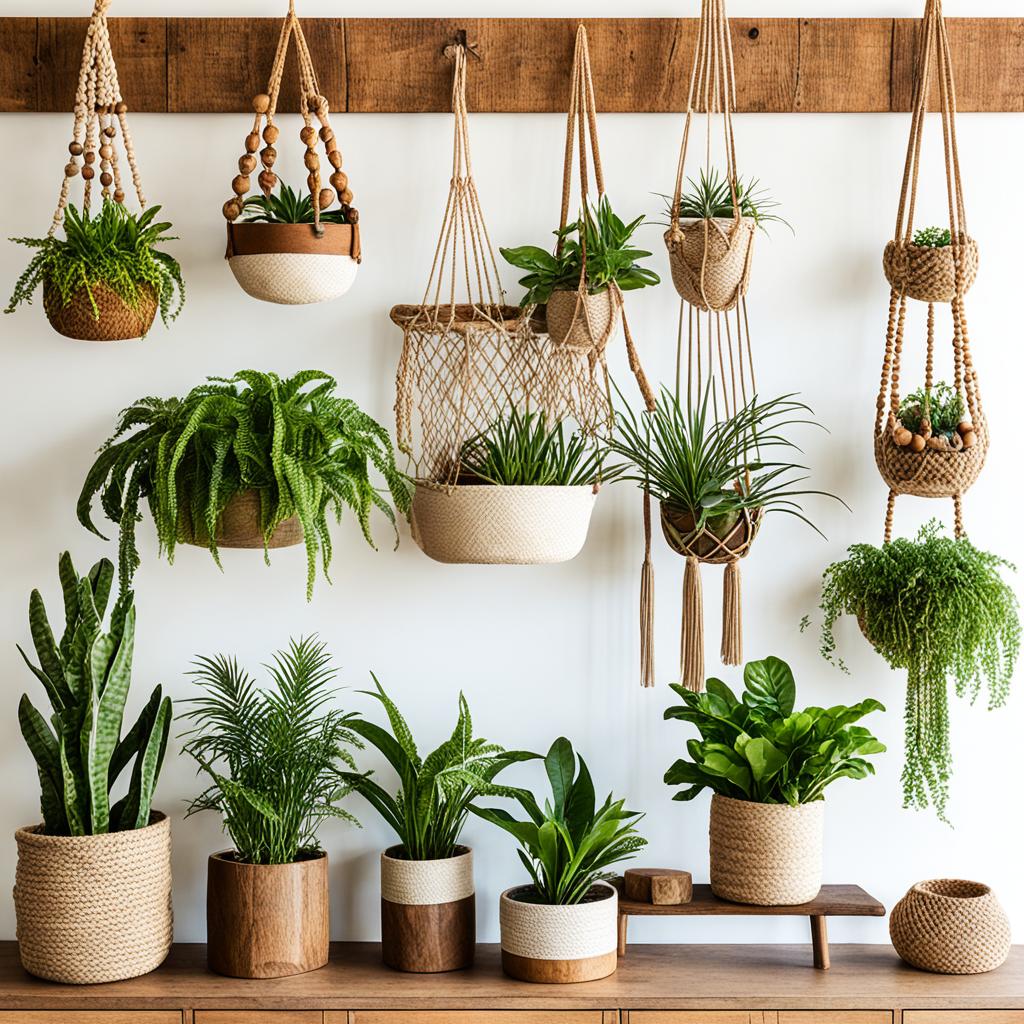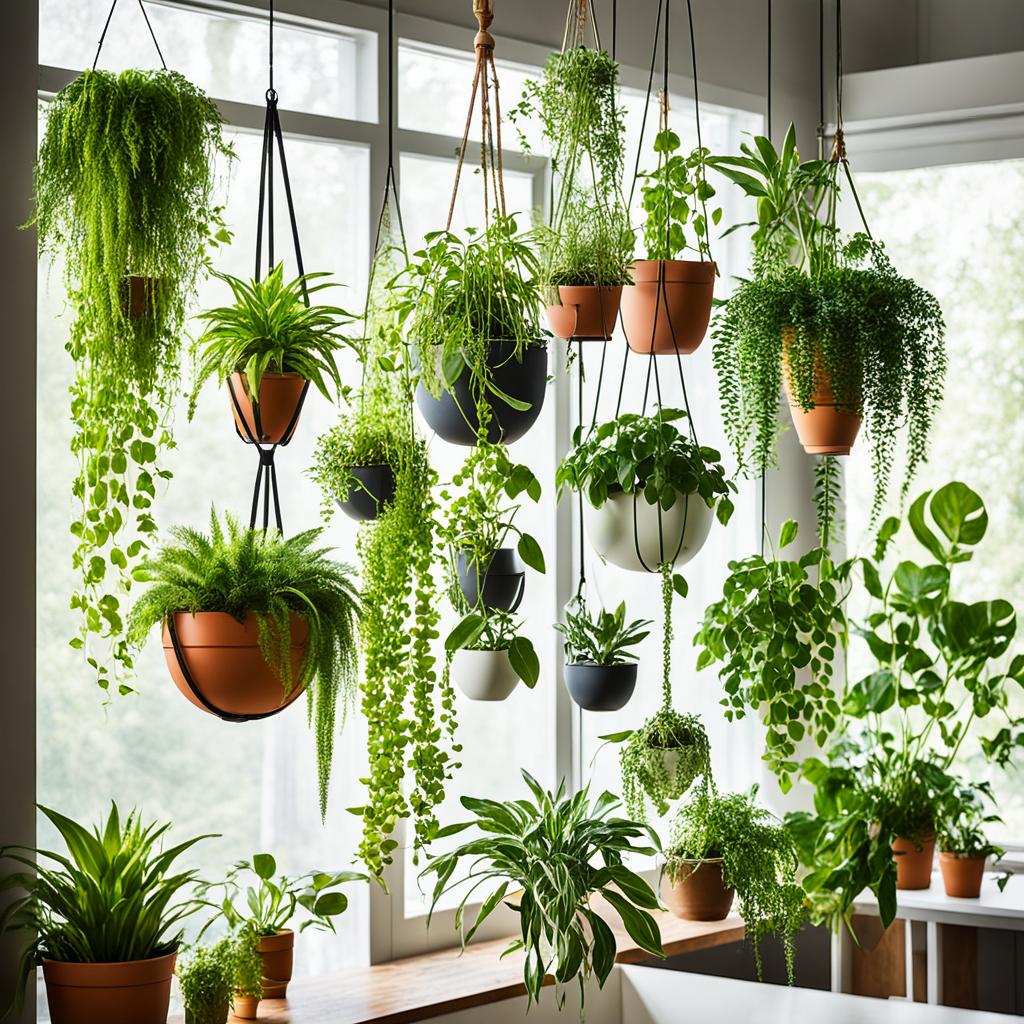Hanging planters are a game-changer for indoor plant lovers. These suspended containers bring nature inside while saving floor space. They create a lush, green oasis in any room.
Indoor hanging plants add botanical decor that transforms living spaces. From cascading vines to compact succulents, there’s a planter for every style.
Vertical gardening with hanging planters is a lasting trend. It adds depth and interest to walls. It also makes rooms feel more spacious by creating the illusion of taller ceilings.
This guide covers choosing the right plant holders and suitable plants. We’ll also share tips on maintaining your green beauties.
You’ll find creative placement ideas and DIY projects here too. These will help you craft your perfect hanging garden.
Let’s explore hanging planters and create a vibrant, green sanctuary in your home.
Introduction to Hanging Planters
Hanging planters add greenery to spaces from apartments to city streets. These suspended gardens offer a unique way to display plants. They create aerial gardens that transform any area.
What are hanging planters?
Hanging planters are containers that hold plants while suspended from ceilings or walls. They range from simple pots to intricate macrame plant hangers. These versatile accessories allow you to create vertical gardens in tight spaces.
Benefits of using hanging planters
Hanging planters offer several advantages:
- Space-saving solution for small areas
- Add visual interest to plain walls and ceilings
- Improve air quality by bringing more plants indoors
- Create privacy and define spaces
- Easy to move and rearrange
Types of hanging planters
You can choose from many hanging planter styles:
| Type | Description | Best for |
|---|---|---|
| Macrame hangers | Woven rope designs | Bohemian decor |
| Ceramic pots | Classic look with drainage | Indoor use |
| Wire baskets | Lightweight and airy | Outdoor spaces |
| Self-watering planters | Built-in reservoir | Low-maintenance plants |
| Wooden boxes | Rustic charm | Herb gardens |

Hanging planters offer endless possibilities for creating green spaces. They suit every taste, from macrame hangers to modern vertical gardens. These versatile planters can transform any area into a lush oasis.
Choosing the Right Hanging Planter
Picking the ideal hanging planter requires thoughtful consideration. Let’s look at key factors to consider when shopping for hanging planter boxes or baskets.
Size Considerations
Size is crucial when selecting a hanging planter. Choose a container 1-2 inches larger than your plant for growth room.
Larger planters, at least 14 inches wide, create stunning floral displays. For globe-type planters, space plants 3-4 inches apart on the sides.
Material Options
Hanging planters come in various materials, each offering unique benefits:
- Ceramic hanging planters: Stylish and moisture-retaining
- Terracotta hanging pots: Breathable and natural-looking
- Rattan hanging baskets: Lightweight and decorative
- Plastic: Affordable and versatile

Drainage and Watering Features
Good drainage is vital for plant health. Self-watering hanging planters are perfect for busy plant owners.
For planters without holes, use LECA to improve drainage. Some designs have removable rubber stoppers for flexible watering options.
| Planter Type | Price Range | Key Feature |
|---|---|---|
| Mkono Modern Ceramic | $10 | Affordable, stylish |
| Hepburn Terra-Cotta | From $33 | Natural moisture control |
| Fabric Plant Hanger | $16 | Lightweight, breathable |
| Suction-Cup Water Creative | $31 (pack of 3) | Unique wall mounting |
The right hanging planter boosts plant health and enhances your home’s décor. Think about your space, plant needs, and style when choosing.
Best Plants for Hanging Planters

Hanging planters are great for showing off cascading greenery and trailing vines. These indoor plants clean the air and bring nature inside. Let’s look at some top choices for your hanging planters.
Pothos and philodendrons are easy to care for and have lush foliage. They grow well in bright indirect light. Spider plants have arching leaves and are great for beginners.
Hoyas and string of pearls add a delicate touch. These succulents need little water and create beautiful cascades. Air plant holders offer a unique look without soil.
- Boston ferns: Perfect for partial shade, reaching up to 3 feet wide
- Ivy: Fast-growing and adaptable, ideal for various light conditions
- Lipstick plants: Vibrant flowers and trailing stems add a pop of color
Think about your space and care needs when choosing plants. Peperomias have over 1,000 species to pick from. You’ll surely find the right fit for your hanging planter.
| Plant | Light Needs | Watering | Growth |
|---|---|---|---|
| Pothos | Bright indirect | When top inch dry | Up to 7 feet long |
| String of Pearls | Bright indirect | Occasional | 2-3 feet long |
| Spider Plant | Medium to bright | Keep soil moist | 1-2 feet wide |
These options will help you create beautiful displays of cascading greenery. Your space will become a lush oasis with these hanging plants.
Hanging Planters: Creative Placement Ideas
Hanging planters can turn any space into a lush oasis. They offer many ways to decorate creatively. Let’s explore how to use hanging planters in your home.
Room Corners and Windows
Corners and windows are perfect for hanging planters. Place cascading ivy near a sunny window for a natural curtain look. In bathrooms, use wall-mounted pot holders for a spa-like feel.

Dividing Spaces
Hanging planters can create green walls in open areas. They divide space without blocking light. Try a tiered planter with trailing plants like spider plants or devil’s ivy.
This method adds multiple plants while saving floor space. It’s great for smaller rooms.
Centerpieces and Focal Points
Make stunning focal points with hanging planters. Group them at different heights for a dynamic living wall. White wall-mounted planters can make a room feel taller.
For a bold look, create an entire plant wall. Use matching flower pot holders for a unified design.
| Placement Idea | Frequency in Examples | Benefits |
|---|---|---|
| Curtain Rod Hanging | 1 out of 30 | Striking visual effect |
| Bathroom Wall Planters | 2 out of 30 | Spa-like atmosphere |
| S-Hook Hanging | 3 out of 30 | Easy access and mobility |
| Tiered Planters | 1 out of 30 | Maximizes vertical space |
Keep your hanging planters within reach for easy care. Expert Hilton Carter suggests this for better maintenance. With these ideas, you can create a beautiful plant-filled space.
Maintenance and Care for Hanging Plants

Hanging plants need special care, especially when it comes to watering. Indoor gardeners often struggle with this aspect. Watering frequency varies based on plant type and environment.
Indoor hanging plants may need more water due to warmer air near ceilings. In summer, daily watering might be necessary. Smaller hanging baskets dry out faster because they have less soil.
Good drainage is vital for indoor plants to avoid water damage. Use a pot-within-pot system or a tray for drainage. Outdoor baskets often use coconut fiber liners, but these aren’t suitable indoors.
- Check care labels before selecting plants
- Deadhead flowers to encourage more blooms
- Trim planters once or twice a season for healthier growth
- Rotate hanging baskets to even out growth
Fertilizing hanging plants helps replenish soil nutrients. This practice creates fuller baskets and boosts plant health. Remember that large, wet hanging baskets can be heavy.
By following these tips and mastering watering techniques, your hanging plants will thrive. With proper care, they’ll add beauty to your space for years to come.
DIY Hanging Planter Projects
Creating your own hanging planters brings nature indoors in a fun way. They’re budget-friendly and let you express your creativity. Many homeowners now make DIY plant hangers, including macramé holders and upcycled planters.

Macramé Hanging Planters
Macramé is popular again, with more people looking for planter tutorials. Making macramé holders is easy and cheap. You only need nylon rope, wooden beads, and scissors.
Basic knots can turn plain planters into eye-catching decor. DIY fans often save money compared to buying ready-made planters.
Repurposed Materials
Upcycled planters are eco-friendly and one-of-a-kind. Turn everyday items into charming plant homes. Old colanders, tin cans, or wooden boxes work well.
One cool project uses recycled plastic bottles and costs just $5. This saves money and reduces waste, fitting the eco-friendly home decor trend.
Customizing Store-Bought Planters
Spruce up plain store-bought planters with easy changes. Paint them, add decorations, or switch the hanging method. You can match any decor style this way.
Home stores sell more wood, screws, and paint for these projects now. People love making their planters unique.
When hanging your DIY planters, use drywall anchors and secure them into studs. These ideas help you make beautiful plant displays for your home.
Outdoor Hanging Planters
Outdoor hanging baskets add life to patios and balconies. These planters save space and bring greenery to your outdoor area. Plastic or metal materials work best, resisting sun and rain.
Balcony planters are ideal for small spaces. Hang them from railings or walls to create a garden feel. Railing planters attach directly to balcony edges, maximizing your outdoor area.

Vertical garden hangers turn blank walls into green oases. They’re great for herbs, flowers, or trailing plants. Mix different planter styles and colors for a vibrant outdoor atmosphere.
| Planter Type | Best Location | Plant Suggestions |
|---|---|---|
| Outdoor Hanging Baskets | Porch ceilings, tree branches | Petunias, fuchsias, ivy |
| Balcony Planters | Railing edges, balcony walls | Geraniums, pansies, herbs |
| Vertical Garden Hangers | Exterior walls, fences | Succulents, ferns, air plants |
Choose plants that can handle direct sunlight and wind. Self-watering planters are great for busy gardeners. They keep plants hydrated even on hot days.
With the right planters and plants, you can create a thriving garden oasis. Your outdoor space will transform into a green haven.
Styling Tips for Hanging Planters
Boost your botanical design skills with these hanging planter styling tips. Learn how to create stunning displays that bring life to any room.
Mixing and Matching Styles
Blend different planter styles, sizes, and heights for a dynamic display. Mix full, rounded plants with trailing varieties for visual interest.
Try pairing a ceramic planter holding a geranium with a cotton cord hanger featuring cascading ivy. This mix of textures and forms adds depth to your greenery accents.
Coordinating with Interior Decor
Match your hanging planters to your interior design theme. Use colors and materials that complement your space.
In a bohemian-style room, wicker planters with flowing pothos create a relaxed vibe. For modern spaces, choose sleek designs with structural plants like dracaena marginata.
Creating Vertical Gardens
Turn blank walls into lush vertical gardens. Group wall-mounted planters to form an eye-catching green feature.
Combine plants like impatiens, lobelia, and bacopa for a colorful, textured look. This approach maximizes space and adds a green touch to compact living areas.
